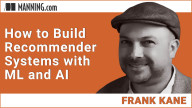videos by Frank Kane
Complete Beginners Guide to XGBoost Models
Take a deep dive into one of the most powerful machine-learning algorithms, eXtreme Gradient Boosting, using a Jupyter notebook with Python.
How to Build Recommender Systems with ML and AI
The advantages, use cases, and methodologies for deploying recommender systems.
Building Recommender Systems
Learn how to build recommender systems from Frank Kane, one of Amazon's pioneers in the field of ML-based recommender systems. In Building Recommender Systems with Machine Learning and AI, you’ll cover tried and true recommendation algorithms based on neighborhood-based collaborative filtering, and work your way up to more modern techniques such as matrix factorization and even deep learning with artificial neural networks. As you go, you’ll develop your own framework for evaluating and combining many different recommendation algorithms together and build your own neural networks using Tensorflow to generate recommendations from movie ratings data. Along the way, you'll learn from Frank's extensive industry experience to understand the challenges you'll encounter when applying these algorithms at large scale and with real-world data.
Machine Learning, Data Science and Deep Learning with Python
Machine Learning, Data Science and Deep Learning with Python teaches you the techniques used by real data scientists and machine learning practitioners in the tech industry, and prepares you for a move into this hot career path. Expert instructor Frank Kane draws on 9 years of experience at Amazon and IMDb to guide you through what matters in data science. The topics in this course come from an analysis of real requirements in data scientist job listings from the biggest tech companies. You’ll cover data science skills employers are looking for, including data visualization in Python with MatPlotLib and Seaborn, transfer learning, sentiment analysis, and experimental design and A/B Tests. Each concept is introduced in plain English, and demonstrated using Python code you can experiment with and build upon. If you're new to Python, don't worry—the course starts with a crash course. When you’re done, you’ll be primed to switch into an exciting new data science career track in the tech industry!
Elasticsearch 7 and Elastic Stack
Frank Kane brings his decade of experience at Amazon.com and IMBD.com to teach you Elasticsearch 7, from installation to operations. You’ll learn what's new in Elasticsearch 7, including tools for managing security with the Elastic stack, and cover the often-overlooked problem of importing data into an Elasticsearch index. You’ll discover that Elasticsearch isn't just for search anymore, learning to use its powerful aggregation capabilities for structured data, including bucketing and analyzing data, and visualizing it using the Kibana web UI. Fuzzy searches, partial matches, search-as-you-type, pagination, sorting—this course covers them all. And it's not just theory! Every lesson has hands-on examples where you'll practice each skill using a virtual machine running Elasticsearch on your own PC.
The Ultimate Introduction to Big Data
The Ultimate Introduction to Big Data teaches you how to design powerful distributed data applications. With lots of hands-on exercises, instructor Frank Kane goes beyond Hadoop to cover many related technologies, giving you valuable firsthand experience with modern data processing applications. You’ll learn to choose an appropriate data storage technology for your application and discover how Hadoop clusters are managed by YARN, Tez, Mesos, and other technologies. You’ll also experience the combined power of HDFS and MapReduce for storing and analyzing data at scale.
Using other key parts of the Hadoop ecosystem like Hive and MySQL, you’ll analyze relational data, and then tackle non-relational data analysis using HBase, Cassandra, and MongoDB. With Kafka, Sqoop, and Flume, you’ll make short work of publishing data to your Hadoop cluster. When you’re done, you’ll have a deep understanding of data processing applications on Hadoop and its distributed systems.
Elasticsearch 6 and Elastic Stack
Elasticsearch 6 and Elastic Stack starts by showing you how to install Elasticsearch 6 on your PC and configure it on a cluster. From there, you’ll learn to bucket and analyze data using Elasticsearch and you’ll monitor your cluster’s health using X-Pack. You’ll set up search indices and query your data using common approaches like fuzzy searches, partial matches, search-as-you-type, and more. This amazing course teaches you to perform rolling restarts, scale up your cluster, and even spin up clusters in the cloud using Amazon Elasticsearch Service and the Elastic Cloud.
With Frank Kane’s practical instruction, you’ll tackle the often-overlooked problem of importing data into an Elasticsearch index. You’ll delve into raw RESTful queries and scripts using Elasticsearch APIs, and you’ll see how Elasticsearch seamlessly integrates with other big data systems like Spark and Kafka. After you’ve mastered Elasticsearch basics, you’ll explore the Elastic Stack. You’ll experience the data processing power of Logstash and pick up data analytics techniques with the interactive Kibana visual dashboard! Every lesson has hands-on examples, so you’ll practice your new search and analysis skills as you go!






